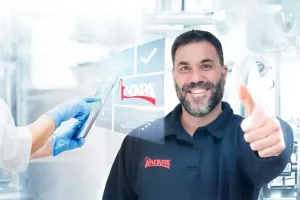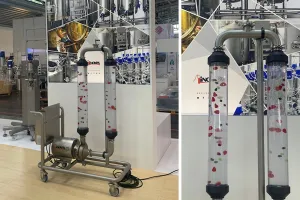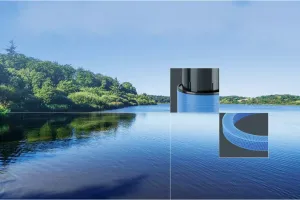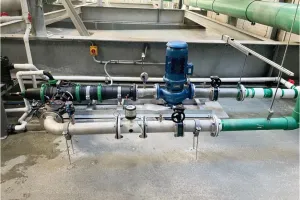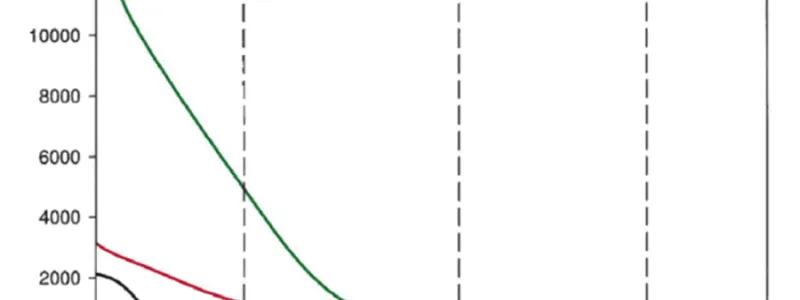
"UV HANOVIA" Chloramines: The hidden cost associated with owning a chlorinated pool
All of us are familiar with the “chlorine” smell of a swimming pool. In reality, it is not the chlorine but the chloramine that we smell in the pool air. When free chlorine from the pool water combines with ammonia present in the sweat and other bodily fluids of swimmers, chloramines are formed. Often an indicator of a high pool load, chloramines have been associated with causing swimming pool asthma and mild to severe irritation of eyes and skin.
Besides causing harm to swimmers, a major impact of chloramines can be seen on pool equipment and infrastructure. Chloramines are extremely corrosive by nature and impact the life of any and all pool equipment, whether it is pool drains or pool side benches. Studies conducted to understand the corrosive impact of chloramines have found significant leaching of iron, loss of structural integrity of rubber (and rubber like elastomers), and even nitrification of cementitious materials. In fact, airborne chloramine has been found to be a leading cause for pool HVAC failures.
Despite the harmful effects of chloramines, chlorine is still a requirement for its ability to provide a long-lasting residual, low cost and high efficacy in killing microorganisms. Chlorine has proven to be a highly effective first line of defence in combating recreational water borne illnesses (RWIs). As a result, several techniques to avoid harmful chloramine formation are employed by pool owners and operators. Some of these include:
Regular monitoring of chloramine levels: Pool maintenance personnel frequently use test kits to measure chlorine and chloramine levels in the pool water. Chloramine levels must be kept below 0.3 ppm to avoid its harmful effects.
Pool shocking: The most common technique to reduce chloramine levels is by shocking the pool with chemicals. Pool shocking may be done either by adding more chlorine or by adding non-chlorine shocking agents such as monopersulfate-based oxidizers.
Investing in a better filtration system: Certain filtration systems can do a good job of removing ammonia from the pool water. Some examples of such filtration systems include sand filters (with added volcanic ash and/or zeolites), Granulated Activated Carbon (GAC) filters, etc.
Daily vacuuming and brushing of the pool to remove any dust that might react with chlorine to produce chloramines.
This is just a small list of activities (often carried out simultaneously) that need to be done to better manage the formation of chloramines. As simple as they sound, these activities can collectively cost a significant sum of money annually. Since these steps need to be conducted as part of regular pool maintenance, it is easy to lose track of this compounding cost. Also, commercial pool facilities must deal with sudden increases in swimmer populations during peak times, further increasing their operational expenses significantly.
Figure 1: UVC energy absorption of mono, di, and trichloramines.
It is no wonder then, that pool operators are moving towards adopting high intensity, broad spectrum ultraviolet (UV) light-based disinfection systems. Specifically, UVC energy (between the range of 200 to 280 nm), has been found to be very effective in breaking down the chloramine molecule. UV light is already well known for its antimicrobial effects, more so for killing chlorine resistant bacteria such as Cryptosporidium. Add to this, the ability to destroy chloramine, and UV comes out to be the most efficient system for providing secondary disinfection and chloramine destruction for any pool owner .
Of course, one can argue that UV systems require additional upfront equipment costs, which are absent in the regular chlorinated pools. However, besides the periodic maintenance costs associated with chlorinated pools, pool owners tend to ignore the costs associated with the peripheral damage of pool equipment. Pool cleaning vacuums, pool lights, pool heaters, diving boards, slides, ladders, stairs, rails, benches, air filtration systems, air exhausts, air conditioners and other building structural elements are just some of the many items that get slowly corroded over time due to the presence of chloramines and other chlorine by-products. In terms of ROI, if the reduced life and accelerated damage to these objects were to be considered, the UV disinfection system would undoubtedly be “the choice” for any pool owner.
Besides causing harm to swimmers, a major impact of chloramines can be seen on pool equipment and infrastructure. Chloramines are extremely corrosive by nature and impact the life of any and all pool equipment, whether it is pool drains or pool side benches. Studies conducted to understand the corrosive impact of chloramines have found significant leaching of iron, loss of structural integrity of rubber (and rubber like elastomers), and even nitrification of cementitious materials. In fact, airborne chloramine has been found to be a leading cause for pool HVAC failures.
Despite the harmful effects of chloramines, chlorine is still a requirement for its ability to provide a long-lasting residual, low cost and high efficacy in killing microorganisms. Chlorine has proven to be a highly effective first line of defence in combating recreational water borne illnesses (RWIs). As a result, several techniques to avoid harmful chloramine formation are employed by pool owners and operators. Some of these include:
Regular monitoring of chloramine levels: Pool maintenance personnel frequently use test kits to measure chlorine and chloramine levels in the pool water. Chloramine levels must be kept below 0.3 ppm to avoid its harmful effects.
Pool shocking: The most common technique to reduce chloramine levels is by shocking the pool with chemicals. Pool shocking may be done either by adding more chlorine or by adding non-chlorine shocking agents such as monopersulfate-based oxidizers.
Investing in a better filtration system: Certain filtration systems can do a good job of removing ammonia from the pool water. Some examples of such filtration systems include sand filters (with added volcanic ash and/or zeolites), Granulated Activated Carbon (GAC) filters, etc.
Daily vacuuming and brushing of the pool to remove any dust that might react with chlorine to produce chloramines.
This is just a small list of activities (often carried out simultaneously) that need to be done to better manage the formation of chloramines. As simple as they sound, these activities can collectively cost a significant sum of money annually. Since these steps need to be conducted as part of regular pool maintenance, it is easy to lose track of this compounding cost. Also, commercial pool facilities must deal with sudden increases in swimmer populations during peak times, further increasing their operational expenses significantly.
Figure 1: UVC energy absorption of mono, di, and trichloramines.
It is no wonder then, that pool operators are moving towards adopting high intensity, broad spectrum ultraviolet (UV) light-based disinfection systems. Specifically, UVC energy (between the range of 200 to 280 nm), has been found to be very effective in breaking down the chloramine molecule. UV light is already well known for its antimicrobial effects, more so for killing chlorine resistant bacteria such as Cryptosporidium. Add to this, the ability to destroy chloramine, and UV comes out to be the most efficient system for providing secondary disinfection and chloramine destruction for any pool owner .
Of course, one can argue that UV systems require additional upfront equipment costs, which are absent in the regular chlorinated pools. However, besides the periodic maintenance costs associated with chlorinated pools, pool owners tend to ignore the costs associated with the peripheral damage of pool equipment. Pool cleaning vacuums, pool lights, pool heaters, diving boards, slides, ladders, stairs, rails, benches, air filtration systems, air exhausts, air conditioners and other building structural elements are just some of the many items that get slowly corroded over time due to the presence of chloramines and other chlorine by-products. In terms of ROI, if the reduced life and accelerated damage to these objects were to be considered, the UV disinfection system would undoubtedly be “the choice” for any pool owner.


